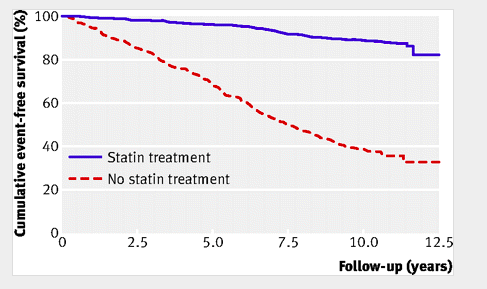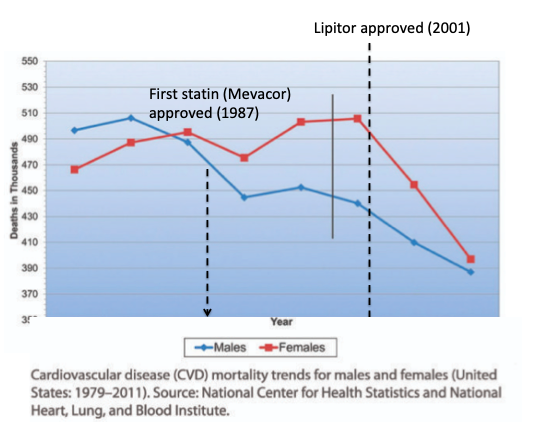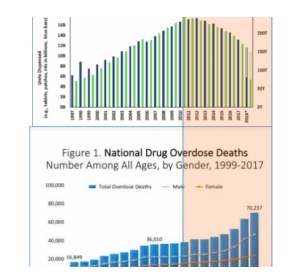Just about any drug can be made to look bad, especially when its risks are considered in the absence of its benefits. This sleazy strategy has been honed to perfection by the anti-opioid Gestapo, who have demonized prescription painkillers so effectively that people who read only news headlines might very well conclude that there is little difference between Vicodin and cyanide. Except, cyanide isn't addictive (1).
The hateful players responsible for the ongoing "War on Pain Patients" have used crappy science, selective evidence and sleight of hand to push their anti-opioid agenda. But you have to hand it to them. Joseph Goebbels would be green with envy of the success of Andrew Kolodny's PROP (2) and its sycophants. They have done a masterful job of manipulating the American public and its policymakers into equating prescription painkillers and heroin (3), which has served only to harm both patients and addicts (4).
Let's play the same game with three other common drugs and see how the results come out.
DRUG A
Drug A is neither addictive nor habituating but is often taken for life. If it is discontinued, those who were taking it will have an increased risk of heart attacks and strokes. Drug A also has an impressive list of common side effects:
- Headache
- Difficulty sleeping
- Flushing of the skin
- Muscle aches, tenderness, or weakness
- Drowsiness and dizziness
- Nausea, vomiting, abdominal cramps, pain, bloating, diarrhea, constipation
- Rash
Drug A can also cause memory loss, confusion, and type 2 diabetes.
Who on earth would take this?
DRUG B
Drug B is also frequently used long-term. While it is not addictive in the strict sense of the word, it is habituating. Its list of side effect looks pretty bad:
- Nausea, vomiting, diarrhea, dry mouth
- Headache
- Drowsiness, dizziness
- Nervousness, agitation, restlessness, insomnia
- Sexual dysfunction (reduced desire, difficulty reaching orgasm, erectile dysfunction
- Change in appetite (may cause weight loss or weight gain)
And when some people abruptly stop taking it they may experience nasty withdrawal symptoms:
- Flu-like symptoms
- Headache
- Gastrointestinal distress (nausea, vomiting, diarrhea)
- Faintness
- Anxiety and depression, suicidal thoughts, mood swings
- Insomnia
- Tremors, loss of coordination
And let's not ignore the conclusion of a study published in the Journal of Clinical Psychiatry
"[Drug B] discontinuation showed a significant risk for suicide attempt."
Valuck RJ, Orton HD, Libby AM., J Clin Psychiatry. 2009 Aug;70(8):1069-77. doi: 10.4088/JCP.08m04943.
Again, why would anyone take this drug?
DRUG C
Drug C is neither addicting not habituating. Nonetheless, it must be taken for life, despite a list of some awful sounding side effects. Here is a partial list:
- Lactic acidosis (can be fatal)
- Increased blood glucose
- Elevated blood cholesterol and triglycerides
- Irreversible liver damage
- Severe skin rashes
- Fever
- Headaches
- Nausea and vomiting
If the side effects are bad, stopping it is far worse:
- Cancer
- Pneumonia
- Thrush
- Cytomegalovirus infection (can lead to blindness)
- Severe weight loss
- Night sweats, fever, chills
- Severe fatigue, muscle
- Mouth ulcers
- Immune system collapse
- Death (100% of the time)
WHAT ARE THESE TERRIBLE DRUGS?
A, B, and C are not drugs. Rather, they are classes of drugs that have similar and common side effects and withdrawal effects.
Drug A is a composite of the statins (Lipitor, Crestor, others). Yes, they work.

Event-free survival with and without statin treatment. The difference is not subtle. Source: British Medical Journal (2008)

The approval of two notable statin drugs and subsequent deaths from cardiovascular disease.
What about all the scary-sounding side effects I listed above? It turns out that they are uncommon.
“We know a lot about statins because they’ve been around for a long time and taken by so many people...The scale clearly tips to benefits in most at-risk patients...But we’ve learned that they also benefit people with lower levels of cholesterol who are at a high risk of heart disease. So we now think of statins as risk-reducing drugs.”
How Statin Drugs Protect the Heart, Michael Blaha M.D., a cardiologist at Johns Hopkins
In other words, although the side effects sound scary, they are relatively rare. Just like opioid addiction in pain patients is possible, but rare.
DRUG B is a composite of the SSRI antidepressants. Although they don't work for everyone they are lifesavers for others. I intentionally included this group because (don't miss the irony here) SSRIs are one of the drug types that are being pushed as an alternative to opioids for certain types of pain. And they don't work very well.
DRUG C is a composite of HAART (highly active antiretroviral therapy) AIDS drugs. Of the three groups, these arguably have the worst side effects but also (by far) the greatest benefit. Prior to 1995, the year when the first HAART drug was approved the death rate for HIV infection was 100%. Now AIDS is rarely mentioned. HIV infection is now more like diabetes than pancreatic cancer. People who are infected in their 20s who take their meds regularly are expected to live close to a normal life span. The AIDS drugs are a medical miracle, but I just made them sound like rat poison by giving only half of the story.
Just like the rats in PROP do.
When anti-opioid zealots like Kolodny, Lembke, and Ballantyne callously bad mouth opioids without also noting their benefits (or falsely denying them) they are doing just what I did in the first half of this article – intentionally making drugs look bad. It's a very easy job. They just happened to "forget" the second part.
An innocent mistake, no doubt.
NOTES:
(1) When used properly, neither are opioids. The evidence is overwhelming.
(2) PROP, a group that will probably go down in flames, is an acronym of Physicians for Responsible Opioid Prescribing, or Physicians Responsible for Opioid Prohibition, as I have named them.
(3) Andy Kolodny, the Godfather of PROP routinely refers to prescription painkillers as "heroin pills." Except they're nothing of the sort. (See Heroin Pills Are Now A Reality - Is Andrew Kolodny Finally Happy?)
(4) It became obvious years ago that as prescription painkillers became harder to get pain patients suffered, an alarming number have committed suicide, and others have been forced to buy street heroin, which is now mostly fentanyl. It is just as obvious that addicts have also been harmed. The inverse relationship between the number of opioid prescriptions and the number of overdose deaths is hardly a coincidence.

(See Gee, Pain Pills Are Not the Real Killers. And The Sun Rises In The East. Who Knew?)



